

Report on the Optical Judging
by Rick Hunter
For several reasons, the optical judging was particularly interesting in 2002. For one thing, it actually took place this year, after a three year hiatus because of weather! This meant that several telescopes were back for the optical contest after having been here in previous years. Sixteen telescopes awaited us up by the Pink Clubhouse. Two were 12.5 inches in size, one was a Cassegrain with all optics made by the builder. One had a mirror pulled into is paraboloidal figure by a mechanism that flexed the glass from behind. Two were nearly identical "scale models" of the telescope William Herschel used to discover Uranus in 1781. Kelly Jons and Gene Zajac constructed functional replicas, with modern glass aluminized mirrors rather than speculum metal!
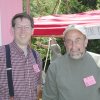
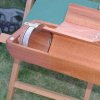
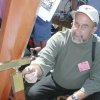
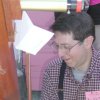
- Name: Kelly Jons & Gene Zajac
- From: Chardon, OH
- Telescope: 4¼-14 Herschelian
Alt-Az Replicas
There were also innovations in the preparation and process. The Convention bulletin gave more detailed info for entrants than before, and the Committee encouraged on-line preregistration. The contest was scheduled for Friday night, so that we could have two chances in case of dubious weather. We decided to try two relatively new ideas to make the actual judging go more smoothly and make better use of time (i.e. finish before dawn!).
The first was a "setup team" of people who went around to all the entrants ahead of time, to prepare them for what's needed from them to make a fair judgment easier. The people were Junie Esslinger, Dave Prowten, Brad Vietje, and Jack Heinzmann, all experienced telescope makers from the Springfield Telescope Makers. Their mission: a pre-check of collimation, and a word to the wise (if needed) to the entrants to tweak the optical systems into line. Also, they would gauge whether the mechanical condition of the telescopes allowed for a steady view to permit examining the image critically.
Finally, as the judges were going about their duties, Jack and Dave went just ahead of them to advise that the eyepiece focal length (in mm) should about equal the f/ratio of the scope to give an appropriate power, and let the contestant know that the scope should be pointed at Altair, high in the south, as the judges were approaching. This was new this year and seemed to work very well. All of the telescopes were properly pointed, reasonably stable, with appropriate powers. Most of them -- ALL THE WINNERS -- were well collimated.
The actual judging group was Rick Hunter, Phil Rounseville, Junie Esslinger and Alan French, with Brad Vietje "in training." Scott Milligan, the previous optical chair, had to bow out this year due to health issues. This left Rick Hunter as the chair. We worked together by consensus, with no decisions that the whole group could not accept. We decided to break up into two groups, each to see about half the telescopes. Then, we would pick the top few in each group, and each group would look at the other group's top picks before coming to a final list of winners. This also worked quite well, as we finished at about 2:00 AM, just as the haze thickened.... More importantly, we easily reached a consensus about ranking the winners. All in all, the process on the field went well.
The ranking announced on the field that night was the overall ranking, regardless of size or complication categories. As it had turned out, one of the 12.5" scopes and the Cassegrain won places in the entire field. These telescopes are all quite wonderful optically, and will, I'm sure, give their builders many years of observing pleasure (as, indeed, will all the entries!). However, after some discussion the next day, we decided to reinstate the traditional categories, and to give a special award. As I announced on Saturday night, no one's place was lowered, while an honorable mention and two "near winners" were promoted.
Credit is due to Iliana Filby and Scott Milligan in particular, for organizing meetings and badgering the rest of us to keep planning and getting ideas ready for the convention booklet, and for the convention itself. Then, Iliana spent most of Friday and Saturday, following a Wednesday last - minute meeting, actually registering people for both competitions and entering data, communicating and serving everyone as a clearing house. I don't think it would have been anywhere near as good, or as fun, without the help of these two, as well as others - I don't even know all the others. For one, Alan Rifkin is already working hard to get things more organized for next year!
THE ENVELOPE, PLEASE
The first category, comprising 13 of the 16 scopes, is Newtonians 12 inches and under. Third place was Bruce Berger, Vice President of the ATMoB from Chelmsford, MA, with an 8" Newtonian, f/5.3, on a German equatorial mounting. Dave McGaw of the STM, from Canaan, NH took second with his 6" Newtonian, also on a German equatorial. The first place winner was Marilyn Michalski, President of the Delaware Valley Amateur Astronomers, from Kimberton, PA. Her 10" Newtonian on a Dobsonian mount is as beautiful to look AT in the daytime as to look THROUGH at night. I believe it took a mechanical award in an earlier year.
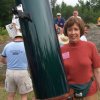
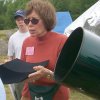
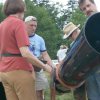
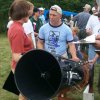
- Name: Marylin Michalsky
- From: Kimberton, PA
- Telescope: 10" f/7 Newtonian
on a Dobsonian Mount
There were two Newtonians, 12.5" in size and as it turned out, both were Dobsonians. Robert Cohen of Peabody, MA took second place. His birch telescope had a homemade focuser and spider. Bob Midiri, also from the DVAA, brought his fine scope back for its third year to take first place in this year's competition.
In the compound or multi-surface category, Dick Parker's beautiful equatorially mounted 10" Cassegrain was the only entry, but was a clear winner, optically indistinguishable, at comparable powers, from the other top winners. Dick conquered the dreaded Cassegrain Secondary.... in spades! He hails from Tolland, CT.
An optical Special Award went to the father and son team of Dennis and Douglas Woos for the flex mirror cell Newtonian, 10" f/5.6, a challenging and innovative project with great promise.
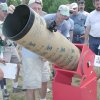

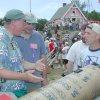
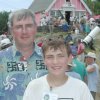
- Name: Dennis & Douglas Woos
- From: New Haven, VT
- Telescope: 10" f/6 Newtonian
on Dobsonian Mount
A little levity helps us enjoy an already enjoyable time. Alan Rifkin threatened us, through the spring, with an exhibit on "amateur telescope baking," and he made good, with a veritable bakery of edible telescopes, lenses, eyepieces, mounts.... No, it wasn't just a Fig Newtonian of his - or our - imagination!
We also remembered, with affection and sadness, Brian Sinnott, whose beautiful birch wood 6" Newtonian was judged mechanically last year. His death prevented it being entered for optical judging this year. He was a wonderful friend, companion, helper at Preconventions in earlier years, and a young full member of the Springfield Telescope Makers. All who knew him will miss him for a long time.
YOUR TURN TO ENTER NEXT TIME?
Some lessons for future entrants: Join a club with a telescope making section! The ATMoB, STM, and DVAA are all such clubs. The advice and guidance they can give you will help you to design your project, and to bring the mirror through to completion! Second, make sure of your mounting as well as your mirror. It will make the scope much easier for you to use, as well as for us to judge! Finally, collimate it well, and make the collimation system easy to use in the dark! That way, you can check it often; even solid telescopes can get knocked out of alignment by the trip to the observing site.
We all hope to see more optical entries from Junior builders in next year's competition! It may be a little scary, for grownups and young people alike, to think that some very picky optical experts will be turning a gimlet eye toward your pride and joy. I think, though, that all the judges, mechanical committee too, want to encourage everyone, much more than we want to criticize. Anything really worth doing is worth doing even not so well - particularly the first time around! Another way of saying it: it's impossible to do it well, unless you at least do it! So get busy, Juniors, women, men: you know who you are, and I know you can build a telescope of your own!
The judges had a lot of fun on Friday night, and we consider it a rare privilege to get to look through such wonderful instruments. They are a message from the hearts and souls of their builders. Your offering them to us for judgment is an act of trust. We, for our part, will keep honing our skills and working on our process to make this a better experience for all in coming years.
Clear skies, and may your pitch be always JUST the right hardness!
Rick Hunter, Stellafane Optical Judging
Back to the 2002 Convention Main Page